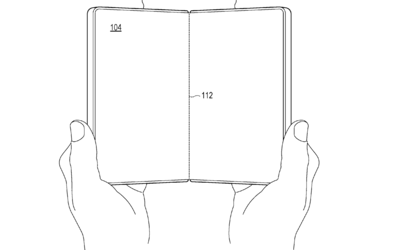Microsoft is reportedly exploring a new approach to foldable smartphone technology, signaling a potential return to the mobile device market after the discontinuation of its Surface Duo line.

A recent patent application, filed with the United States Patent and Trademark Office on February 29, unveils the company's concept for a foldable device featuring a unique single-hinge system, dubbed the "spine cover plate."
The patent suggests a design akin to the Samsung Galaxy Z Fold, employing a "flexible display" in a book-style configuration. The core innovation lies in the spine cover plate mechanism, which aims to safeguard the device's single hinge. This cover plate is designed to shield the structural element, enhancing its durability.
The key differentiator between conventional hinges and Microsoft's design is the spine cover's automatic adjustment during opening and closing. This aims to eliminate unnecessary gaps around the hinge, providing enhanced protection against dust and water ingress. Currently, Samsung's foldable devices offer an IPX8 rating, providing water resistance only.
Microsoft's patent indicates that this new hinge mechanism has the potential to make the hinge crease less visible compared to current foldable options.
Furthermore, the company outlines methods to reduce the overall thickness of the foldable smartphone. The spine cover plate can move closer to the device's hinge when folded, resulting in a more compact form factor.
Microsoft explains in the patent that retracting the spine cover plate towards the central spine reduces the width of the folded computing device, enabling easier and more comfortable handling, potentially with one hand.
The smartphone industry is actively seeking solutions to eliminate the crease inherent in foldable displays. While some manufacturers have implemented water-drop folding mechanisms to mitigate this issue, a truly crease-free foldable device has yet to emerge. The durability of foldable devices, given their numerous moving parts, also remains a crucial consideration.
Introducing an additional layer or movable component, such as the spine cover plate, may raise concerns about complexity and potential points of failure, despite the enhanced durability Microsoft claims in its patent application.
Newer articles
Older articles
 Aditya Narayan Calls for Entertainment Industry Reform, Citing Personal Burnout Struggle
Aditya Narayan Calls for Entertainment Industry Reform, Citing Personal Burnout Struggle
 Rishabh Pant's "Game-Changing" Innings Draw Adam Gilchrist Comparisons from Greg Chappell
Rishabh Pant's "Game-Changing" Innings Draw Adam Gilchrist Comparisons from Greg Chappell
 Gavaskar Urges India to Replace Thakur with Yadav for Second Test Against England
Gavaskar Urges India to Replace Thakur with Yadav for Second Test Against England
 Greg Chappell: Rishabh Pant Redefining Cricket with Revolutionary Batting Style
Greg Chappell: Rishabh Pant Redefining Cricket with Revolutionary Batting Style
 Wimbledon 2025: Streaming Guide for India & US Fans - Dates, Prize Money, and How to Watch Online
Wimbledon 2025: Streaming Guide for India & US Fans - Dates, Prize Money, and How to Watch Online
 Nitish Rana Set for Delhi Comeback After Disappointing Uttar Pradesh Spell
Nitish Rana Set for Delhi Comeback After Disappointing Uttar Pradesh Spell
 Google Maps Enhances Navigation Accuracy with Fused Orientation Provider API Update
Google Maps Enhances Navigation Accuracy with Fused Orientation Provider API Update
 Dhillon's Explosive Batting Display Propels Him to MI New York Spotlight
Dhillon's Explosive Batting Display Propels Him to MI New York Spotlight
 Moeen Ali's Legacy: 'Uncle Munir' Continues Family Cricket Dynasty in Birmingham, One Grandchild at a Time
Moeen Ali's Legacy: 'Uncle Munir' Continues Family Cricket Dynasty in Birmingham, One Grandchild at a Time
 X Crackdown: Platform Bans Half a Million Indian Accounts Over Policy Violations
X Crackdown: Platform Bans Half a Million Indian Accounts Over Policy Violations